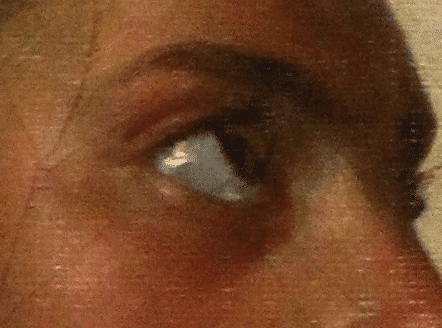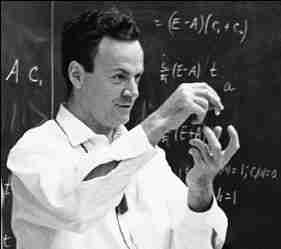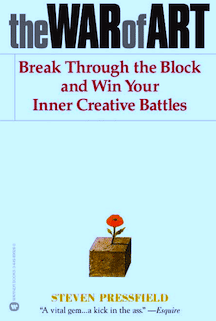Imagine that you’re strolling through an art museum on a lazy afternoon. Leisurely, you walk past magnificent paintings, weave between rows of sculpture, and meander through various galleries, each showcasing a bygone era of human artistic accomplishment. By chance, a particular painting catches your eye from across the room. You’re immediately struck by the realistic landscape, the beckoning expression on the subject’s face, and the story depicted on that weathered canvas. The work triggers emotion, forgotten memories, and a peculiar sense of nostalgia. On some unconscious level you feel a mysterious connection to this work. This is your first impression, that visceral experience of the entire work as a whole felt from the first contact.
For some reason, you are compelled to take a few steps forward to get closer to the painting. As you inch toward the canvas, a subtle shift suddenly occurs. Your eyes open to another plane of visual awareness and a completely different side of the painting becomes the focus. Brush strokes become visible, an expressive palette of natural, earthy colors reveals itself, and curiously, imperfections become readily apparent.
At this level, the ideas and emotions portrayed in the work can not be separated from the artistic technique required to produce it – an actual person painstakingly created this! You can see the specific techniques that were used to create those intriguing visual effects that you experienced from afar. Questions begin to surface in your mind about the technical aspects of the painting: “How did the artist create this? Where did they start? What techniques did they use? Would I be able to produce this if I tried?”
Then, once again, you step back from the painting. Those brush strokes, subtle colors, and imperfections are transformed anew into the figures, landscapes, and symbols that you pondered on your first look. Those finite elements of artistic technique once again become ideas, emotion, and meaning, unique to each person that gazes upon the painting. From this distance, you don’t even think about the techniques that went into creating this work, the entire piece just hits you at once.
Back and forth you go, switching perspective of your own accord. From one distance you experience the intangible meaning of the work and from another, you appreciate the skill involved – so it goes, Ideas from one side and Technique from another.
Experience vs. analysis
This experience is true of any type of art form that you encounter. You can contemplate the work as a whole, replete with ideas, style, and emotion or you can focus on a small piece of it, studying and eventually imitating the techniques required to produce it.
As musicians, we confront this two-sided dilemma all the time. Anytime that you put on a record, you can either concentrate on the sound, phrasing, and feeling of the music or you can intellectualize it, analyzing the technique and reducing it to the theory involved.
From one perspective we capture the spirit of the music and from another we learn how to perform it. Both are essential for the successful improviser, but getting lost in one side can adversely affect the other. For the majority of improvisers, most of the time spent in the practice room is filled with technical exercises and an in-depth analysis of tunes and solos – the nuts and bolts of improvisation.
However, by studying just one small piece of the work for weeks at a time, are we losing sight of the big picture? Moreover, is the study and analysis of these lines and songs inhibiting an objective experience of music in general?
“Poets say science takes away from the beauty of the stars – mere globs of gas atoms. I, too, can see the stars on a desert night, and feel them. But do I see less or more? The vastness of the heavens stretches my imagination – stuck on this carousel, my little eye can catch one-million-year-old light.”~Richard Feynman
The preferred method of learning an art form, especially in jazz, is deconstruction. We find a solo of that resonates with us emotionally, intellectually, and artistically, we transcribe it, reduce it to its main components, analyze these parts, and practice them intently. Essentially, taking those magical sounds that we like and turning them into tangible techniques that we can practice and recreate in our own playing.
But, does this method aid the artistic process and sustain the “idea” of music or does it detract from the experience and alter it in some immutable way?
For instance, can a film student enjoy a film without thinking about camera angles, screen writing, or acting technique? Can a bibliophile versed in literary theory simply read a novel without parsing sentence structure, analyzing themes, and continually interpreting symbols? Can a devoted musician listen to a piece of music without thinking about chord structure, melodies, and analyzing form?
Once we study an art form, is our beginner’s mind gone forever? Will we never be able to return to the “idea” of the work that we experienced on our first impression after we know the technique required to produce it?
Because we’re continually taking solos, tunes, and harmonies apart in our efforts to learn improvisation, we are in continual danger of forgetting the overall purpose of the music. Yet, we cannot move forward as an improviser without this type of technical practice and thinking. This is the dilemma that we confront every time we transcribe a solo or focus intently on one aspect of our technique.
The necessity of technique
Technique is necessary for any art form, whether it’s improvisation, painting, or photography. In order to become proficient, you must study the basics and to move forward, requires hours upon hours of focused practice. There’s no getting around this fact.
As musicians, this means studying theory and form, analyzing harmony and chord progressions, and working relentlessly to improve your instrumental technique. Technique allows us to understand the inner workings of music and put a name on those “ideas” and emotion that draw us to a piece of music in the first place.
When you focus on the techniques involved in a solo or a piece of music, you are discovering for yourself the specific skills that will allow you to one day perform them. In addition to that, you are gaining an insight into the music that is hidden from the casual observer.
By taking the time to slowly learn each note, articulation, and melodic device, you’re not only understanding the music on a deeper level, you’re developing a greater appreciation of the art of improvisation. With these tools you’ll be able to listen to any piece of music and identify devices that you can practice and eventually be able to master.
In other words, technique will inevitably become the vehicle for your expression.
The magic of the “idea”
Inspiration. Emotion. Style. Ideas. These are the intangible elements of art that draw us to music and propel us to improve, discover, and explore our interests and talents. It’s the personality imbued in our work that comes from unknown origins, the voice of the muse.
The “idea” in jazz resides in the instantly recognizable sound of Coltrane, the unique and masterful style of Bird, and the impeccable phrasing of Clifford Brown. Each of these musical personalities inspires emotion and meaning within each person that listens to them.
A master in any discipline has a mastery of technique, but when you encounter them, you are left with style, purpose, and emotion – technique is merely an afterthought.
When you deconstruct a work and focus solely on the technique of an art form, you lose something essential. Reducing the work of Monet to brush strokes, pastels, and water lilies is akin to reducing the music of Charlie Parker to double time lines, triplet rhythms, and b9’s. Yes, these were a few techniques that these masters often employed, but they are by no means the essence of their work.
You’ve surely heard players that improvise with technical proficiency and don’t play any wrong notes, yet, their solos are somehow lacking and devoid of life. They’ve studied the theory and worked out the technique, but something is missing. Without emotion or an artistic vision, those lines, scales, and technique have little effect on anyone, anywhere.
Using both perspectives to your advantage
“The professional dedicates himself to mastering technique not because he believes technique is a substitute for inspiration, but because he wants to be in possession of the full arsenal of skills when inspiration does come.”~Steven Pressfield from The War of Art
Put on a recording that you’re unfamiliar with. What is your first impression? Are you affected by the mood of the piece and the personality of the soloist or are you thinking about the form of the tune, ii-V progressions, and the time signature? Do you hear different sides of the music on each successive listening?
So, which perspective is correct? Well, neither! A well-rounded musician must have both. On one listen you need to hear the “ideas” of the soloist and on another you must focus on the “technique.” After some time and practice, you’ll eventually be able to hear both perspectives at the same time with a slight shift of your attention.
Ideas can become technique and technique can be transformed into ideas. These two perspectives go hand in hand, dependent upon the other for complete musicianship. Your instrumental technique and theoretical knowledge aid your musical expression, and your style and expression give a purpose to that technique.
Don’t become the improviser with technical facility but little to say musically, and on the other hand, avoid the trap of becoming an improviser with interesting musical ideas, but no technique and knowledge to execute those ideas.
As a listener and a performer, strive to hear and interpret a piece of music from both perspectives. Break apart the work, understand the form, study the harmony, analyze the musical lines, and imitate the techniques to gain a greater understanding and appreciation of the work. However, don’t lose sight as to what the piece of music is about.
Remember that the “idea” side of music is essential to communicating with listeners. Of course, in the practice room you need to break apart the music and separate it into technique, but keep in mind that these “techniques” aid the “idea” of your music. Listen to your favorite player and you’ll hear the ultimate goal of any musician: Idea and Technique unite to become one at the end of the day – it’s all just music.













